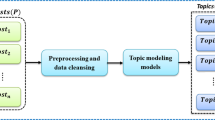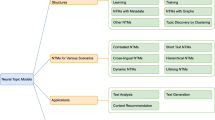Abstract
With the rapid development of social media, the topics emerge and propagate in a variety of media websites. Although much work has been done since NIST proposed the problem of topic detection and tracking (TDT), most of them focus on single media data and are mainly based on unsupervised clustering method, which does not use some side information to help detecting topics. Therefore, traditional TDT approaches are not competent for cross-media topic detection. To efficiently use the information contained in multi-modal data from different sources and the prior knowledge, we propose a semi-supervised co-clustering approach for cross-media topic detection by a constrained non-negative matrix factorization. The correctness and convergence of our approach are proved to demonstrate its mathematical rigorousness. Experiments on the cross-media dataset verify the effectiveness of our proposed approach.






Similar content being viewed by others
References
LDC (1999) TDT3 evaluation specification version 2.7
He Q, Chang K, Lim EP (2007) Analyzing feature trajectories for event detection. In: ACM SIGIR conference
Mei Q, Zhai C (2005) Discovering evolutionary theme patterns from text: an exploration of temporal text mining. In: ACM SIGKDD international conference on knowledge discovery and data mining
Allan J, Carbonell J, Doddington G, Yamron J, Yang Y (1998) Topic detection and tracking pilot study: final report. In: Proceedings of the DARPA broadcast news transcription and understanding, workshop, pp 194–218
Fiscus JG, Doddington GR (2002) Topic detection and tracking evaluation overview. In: Topic detection and tracking: event-based information organization
Liu L, Sun L, Rui Y, Shi Y, Yang S (2008) Web video topic discovery and tracking via bipartite graph reinforcement model. In: International world wide web conference
Cao J, Ngo CW, Zhang YD, Li JT (2011) Tracking web video topics: discovery, visualization and monitoring. IEEE Trans Circuits Syst Video Technol 21(12):1835–1846
Sun AX, Hu MS (2011) Query-guided event detection from news and blog streams. IEEE Trans Syst Man Cyber Part A Syst Hum 41(5):834–839
Chen TL, Liu CX, Huang QM (2012) An effective multi-clue fusion approach for web video topic detection. In: ACM multimedia
Zhao Q, Liu T-Y, Bhowmick SS, Ma W-Y (2006) Event detection from evolution of click-through data. In: ACM SIGKDD international conference on knowledge discovery and data mining, pp 484–493
Xu W, Liu X, Gong Y (2003) Document clustering based on non-negative matrix factorization. In: Proceedings of the 26th annual international ACM SIGIR conferece research and development in information retrieval, pp 267–273
Yang Y, Carbonell J, Brown R, Pierce T, Archibald BT, Liu X (1999) Learning approaches for detecting and tracking news events. IEEE Intell Syst 14(4):32–43
Saha A, Sindhwani V (2012) Learning evolving and emerging topics in social media: a dynamic NMF approach with temporal regularization in WSDM, pp 693–702
http://projects.ldc.upenn.edu/TDT/. Accessed June 2013
He Q, Chang K, Lim E, Banerjee A (2010) Keep it simple with time: a re-examination of probabilistic topic detection models. IEEE Trans Pattern Anal Mach Intell 32(10):1795–1808
Zhang YY, Li GR, Chu LY, Wang SH, Zhang WG, Huang QM (2013) Cross-media topic detection: a multi-modality fusion framework. In: ICME
http://news.sina.com.cn/. Accessed June 2013
http://www.youku.com/. Accessed June 2013
Yang Y, Pierce T, Carbonell J (1998) A study on retrospective and online event detection. In: Proceedings of the 21st annual international ACM SIGIR conference on reserach and development in information retrieval, Melbourne, Australia, pp 28–36
Wang CH, Zhang M, Ma SP, Ru LY (2008) Automatic online news issue construction in web environment. In: International world wide web conference
Banerjee A, Dhillon IS, Ghosh J, Merugu S, Modha DS (2004) A generalized maximum entropy approach to bregman co-clustering and matrix approximation. In: ACM SIGKDD international conference on knowledge discovery and data mining, pp 509–514
Dhillon IS et al (2001) Co-clustering documents and words using bipartite spectral graph partitioning. In: ACM SIGKDD international conference on knowledge discovery and data mining, pp 269–274
Dhillon IS, Mallela S, Modha DS (2003) Information-theoretical coclustering. In: ACM SIGKDD international conference on knowledge discovery and data mining, pp 89–98
Shao J, Ma S, Lu WM, Zhuang YT (2012) A unified framework for web video topic discovery and visualization. Pattern Recogn Lett 33(4):410–419
Gao B, Liu T-Y, Feng G, Qin T, Cheng Q-S, Ma W-Y (2005) Hierarchical taxonomy preparation for text categorization using consistent bipartite spectral graph copartitioning. IEEE Trans Knowl Data Eng 17(9):1263–1273
Long B, Wu X, Zhang Z, Yu PS (2006) Spectral clustering for multi-type relational data. In: International conference on machine learning, pp 585–592
Ding C, Li T, Peng W, Park H (2006) Orthogonal nonnegative matrix tri-factorizations for clustering. In: ACM SIGKDD international conference on knowledge discovery and data mining, pp 126–135
Li P, Bu J, Chen C, He Z, Cai D (2013) Relational multimanifold coclustering. IEEE Trans Cybern 43(6):1871–1881
Li T, Zhang Y, Sindhwani V (2009) A non-negative matrix tri-factorization approach to sentiment classification with lexical prior knowledge. In: Proceedings of the joint conference of the 47th annual meeting of the association of computational linguistics, Suntec, Singapore, pp 244–252
Wang F, Li T, Zhang C (2008) Semi-supervised clustering via matrix factorization. In: Proceedings of the SIAM international conference on data mining (SDM), Atlanta, GA
Chen Y, Wang L, Dong M (2009) Non-negative matrix factorization for semi-supervised heterogeneous data co-clustering. IEEE Trans Knowl Data Eng 22(10):1459–1474
Xue Z, Jiang S, Li G, Huang Q, Zhang W (2013) Cross-media topic detection associated with hot search queries. In: Proceedings of fifth international conference on internet multimedia computing and service, pp 403–406
Lee D, Seung H (1999) Learning the parts of objects by non-negative matrix factorization. Nature 401:788–791
Li T, Ding C, Jordan MI (2006) Solving consensus and semi-supervised clustering problems using non-negative matrix factorization. In: Proceedings of ICDM, pp 362–371
http://ictclas.org/ictclas_download.aspx. Accessed June 2013
Xie L, Natsev A, Kender JR, Hill ML, Smith JR (2011) Visual memes in social media: tracking realworld news in youtube videos. In: ACM multimedia pp. 53–62
http://hot.news.baidu.com/. Accessed June 2013
Acknowledgments
This work was supported in part by National Basic Research Program of China (973 Program): 2012CB316400, in part by National Natural Science Foundation of China: 61025011, 61332016, 61202322, 61202234 and 61303153, by Municipal Natural Science Foundation of Beijing: 4132010 and KZ201310005006, and by China Postdoctoral Science Foundation: 2012M520436.
Author information
Authors and Affiliations
Corresponding authors
Appendix
Appendix
The proof of the correctness and convergence of Algorithm 1 is given in this section.
1.1 Correctness of the algorithm
We first prove the correctness of Algorithm1 and have the following theorem.
Theorem 1
If the update rule of \({\mathbf{F}}\), \(\{{\mathbf{S}}^{(i)}\}_{1\le i\le h} \) and \(\{{\mathbf{G}}^{(i)}\}_{1\le i\le h} \) in Algorithm 1 converges, then the final solution satisfies the KKT condition.
Proof
Following the standard theory of constrained optimization, we introduce the Lagrangian multipliers \(\lambda _f \), \(\lambda _{S^i} \) and \(\lambda _{G^i} \) and minimize the Lagrangian function
The zero gradient condition gives
From the complementary slackness condition, we obtain
Equations (22), (23) and (24) are the fixed point equations that the solution must satisfy at convergence. It is obvious that the limiting solutions of the update rules of (7), (8) and (9) satisfy these fixed point equations. For example, we have \({\mathbf{S}}^{{(\mathrm{i})}^{\infty }}={\mathbf{S}}^{{(\mathrm{i})}^{{\mathrm{t}+1}}}={\mathbf{S}}^{{(\mathrm{i})}^{\mathrm{t}}}\) at convergence, so the update rule of (7) becomes
then we obtain
which is identical to Eq. (23). Similarly, we can see the update rule of (8) and (9) is identical to Eqs. (24) and (22), respectively. So the solution satisfies the KKT condition at convergence. The proof is completed. \(\square \)
1.2 Convergence of the algorithm
We now prove the convergence of the algorithm. First, we assume that \(\{{\mathbf{S}}^{(i)}\}_{1\le i\le h} \) and \(\{{\mathbf{G}}^{(i)}\}_{1\le i\le h}\) are fixed matrices, then the objective function (6) can be written as
where we ignore the constant \({\mathbf{R}}^{{(\mathrm{ci})}^{T}}{\mathbf{R}}^{(\mathrm{ci})}\) and \({\mathbf{Y}}^T{\mathbf{UY}}\).
Theorem 2
The objective function \(J_1 ({\mathbf{F}})\) is monotonically nonincreasing under the update rule (9).
To prove Theorem 2, we will make use of auxiliary function approach in [37]. We first introduce the definition of auxiliary function.
Definition 1
\(Z(H,\widetilde{H})\) is an auxiliary function for \(X(H)\) if the conditions
are satisfied.
Lemma 1
If \(Z\) is an auxiliary, then \(X\) is nonincreasing under the update
Proof
\(X(H^t)=Z(H^t,H^t)\ge Z(H^{t+1},H^t)\ge X(H^{t+1})\). The proof is completed. \(\square \)
So the key is to find an appropriate auxiliary function \(Z({\mathbf{F}},\widetilde{{\mathbf{F}}})\) of \(J_1 ({\mathbf{F}})\).
Proof of Theorem 2
Now we show that
is an auxiliary function of \(J_1 ({\mathbf{F}}^{\mathrm{t}+1})\). First, it is obvious that the equality \(J_1 ({\mathbf{F}}^\mathrm{t})=Z({\mathbf{F}}^\mathrm{t},{\mathbf{F}}^\mathrm{t})\) holds. Then the inequality \(Z({\mathbf{F}}^{\mathrm{t}+1},{\mathbf{F}}^\mathrm{t})\ge J_1 ({\mathbf{F}}^{\mathrm{t}+1})\) holds because: the first term in \(J_1 ({\mathbf{F}}^{\mathrm{t}+1})\) and \(Z({\mathbf{F}}^{\mathrm{t}+1},{\mathbf{F}}^\mathrm{t})\) is equal, and the second and third term in \(Z({\mathbf{F}}^{\mathrm{t}+1},{\mathbf{F}}^\mathrm{t})\) is always bigger than in \(J_1 ({\mathbf{F}}^{\mathrm{t}+1})\) [27].
According to Eq. (26), we find the minimum of \(Z({\mathbf{F}}^{\mathrm{t}+1},{\mathbf{F}}^\mathrm{t})\) fixing \({\mathbf{F}}^\mathrm{t}\). The minimum is obtained by
then we can get the update rule (9) by solving \(F^{t+1}\):
So under this update rule, function \(J_1 ({\mathbf{F}})\) is monotonically nonincreasing. The proof is completed. \(\square \)
So far we assume \(\{{\mathbf{S}}^{(i)}\}_{1\le i\le h} \) and \(\{{\mathbf{G}}^{(\mathrm{i})}\}_{1\le i\le h} \) are fixed matrices. Alternatively, we can also fix \({\mathbf{F}}\) and \(\{{\mathbf{G}}^{(\mathrm{i})}\}_{1\le i\le h} \) or \({\mathbf{F}}\) and \(\{{\mathbf{S}}^{(i)}\}_{1\le i\le h} \), and the proof for convergence of the update rules of (7) and (8) is similar.
Rights and permissions
About this article
Cite this article
Xue, Z., Li, G., Zhang, W. et al. Topic detection in cross-media: a semi-supervised co-clustering approach. Int J Multimed Info Retr 3, 193–205 (2014). https://doi.org/10.1007/s13735-014-0056-x
Received:
Revised:
Accepted:
Published:
Issue Date:
DOI: https://doi.org/10.1007/s13735-014-0056-x




